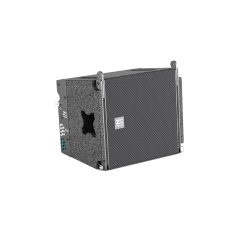Comparing 12 inch line array speakers against bigger models, there are plentiful of factors and key entities which drives their performance state of dominance in the realm where they are accommodated as handy components means also cost effective. As the 12 inches tells us, this particular speaker can handle low frequencies better than those with smaller drivers. Because they have a bigger surface area to move the air, larger speakers (like 15-inch and 18-inch models) generally also do better-and sound louder-at reproducing very low bass. On the other hand, 12 inch line array speakers are a compromise between them because they offer enough low-end to add fullness in tracks but at the same time with much more reasonable size.
You also have to consider power handling. A standard 12 inch line array speaker can manage power from 500 to as much as up to1,200 watts RMS depending on the model. Larger models may handle higher wattages — 2,000 watts or more in some cases. The main difference is that bigger speakers can output higher sound pressure levels (SPL), and they are more commonly used in larger spaces or out-of-doors venues where there's simply a need for high volume to reach long distances audience. Whereas, solid 12-inch speakers in a properly-engineered line array can generate enough SPL for mid to large rooms', giving good power vs portability.
Weight and size of the speakers also make them ideal for your settings. This is exacerbated further if you venture into larger models (such as ones with 15-inch, or even 18-inch drivers) which are more cumbersome and heavier requiring tougher rigging solutions for safe transport. You will find that a 12″ line array speaker weighs anywhere from around 50 – 80 plus pounds depending on the model you are using with very large models weighing well over one hundred. Because of this, the 12 inch form factor is more flexible and can be set up quickly in a smaller space such as trade show or other temporary environment.

Event organizers and audio professionals will be wary of cost-efficiency It is inherently more expensive to build larger speakers, just in terms of material cost and the physical labor involved on top of it needing better amplification or extra rigging. Common 12 inch line array speakers can be anywhere in the ballpark of a thousand or two to each unit and if you get into larger models, they might go from around twenty-five hundred up to five grand. Several speakers may be required to cover a sizeable area, making the difference in tarp prices significant enough that it can change an event's budget entirely. As a result, the 12 inch version offers good value for money and is not that far off performance-wise to make it pretty ideal for people with medium-large events.
Size also comes heavily into play with frequencies. Certainly, bigger speakers are better equipped to handle lower frequencies more efficiently than smaller ones; but 12 inch models typically have a flatter frequency response covering the midrange and high-frequencies with greater accuracy. This makes them a good choice for applications where intelligible speech and natural musical clarity are critical, such as corporate events, theaters or houses of worship. A perfect example is the 2020 Tokyo Olympics where many small venues resorted to a pair of local flown or ground stackable, twelve-inch line array systems because they provided loudspeakers that could provide precise and intelligible audio output yet did not flood them with excessive bass energy.
When it comes to versatility, 12 inch line array speakers are a little more versatile than the larger ones. Their smaller size makes them easier to fit into a variety of venues, from concert halls to the great outdoors. This opinion is echoed by the likes of industry veteran John Meyer (founder, Meyer Sound), "A 12 inch line array that has been well designed can sound great in a large variety of situations", he states.
This is another reason for the 12″ speaker system products to be enjoyed so much other than using with a line array systems – modularity. Sound engineers can stack multiple units to tailor coverage area and SPLs for any given application. Although fewer larger speakers will achieve the same SPLs, multiple 12 sources are easier to articulate and can be placed strategically to smooth our coverage helped reduced then number of feedback issues or dead spots.
Its powerful line array sound is reinforced by 12 inch speakers and fitted inside a compact cabinet, delivering superior performance with unmatched simplicity. An ideal solution for events needing a combination of low end power and overall sound clarity, these speakers are widely used by professionals who rely on high quality performance.